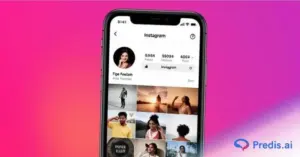From using Reels in Instagram to put your brand in front of a new audience and uploading long tutorials to YouTube, we all use videos in our marketing strategy. In fact, we use so many videos in our strategy that keeping up with the sheer amount of them has become a hassle no less. This is where a video content calendar creation comes into action.
If you are not aware of them and need help with keeping up with your videos, then this blog has all the answers for you. Let’s dive in!
What is a Video Content Calendar?
Videos are great tools for storytelling. You can actually relay all the information in a streamlined way and keep the audience engaged much better with a video, rather than an image or a carousel.
Since videos are a great way to grow your audience, any marketer would have a huge batch of them planned out to go. But the thing is, tracking all of them, the stage of development they are in, the platform it is supposed to go out to, in a crusty spreadsheet will not do. Chances are, all these details will be scattered in various areas, making you more confused than ever.
To avoid this situation, there is a simple enough solution to adopt. This is a Video content calendar creation with AI. This will ensure that you will be able to get the following information at a glance:
- Video topics and themes they are under
- Schedule of when the post will be going out
- The platform it will be posted on
- The type of video it is going to be, such as tutorials or testimonials
- Call to Action
- The team member who is working on the video
With all this comprehensive data in one place, you get a perfect overview of the videos that you will be posting for the upcoming month.

What are the advantages of having a Video Content Calendar?
But why is video content calendar creation such an important thing? What do you actually gain out of this? Well, to answer that, let us find out why a video calendar can be a great addition to your strategy:
- Helps maintain consistency even when you have a crazy schedule
- Helps plan and post videos as part of a larger marketing campaign
- Since you have ample time to produce and plan your videos, there will be no compromise on quality, which often happens in rushed video creations.
- Wearing multiple hats is a part of a creator’s job. By having videos sorted for the rest of the month, you take one stress factor out of the equation.
- Helps communicate the timeline better to your team members and stakeholders. A calendar with all the information is much better than a spreadsheet crammed with tons of details that make no sense.
- Helps in repurposing because you know which posts are on which platform. This will give you ideas on how you can make it suitable for a different social media channel.
With a content calendar in place, you will be sorted for an entire month or whatever duration you choose to plan for. This way, the time and resources that would have otherwise gone into this could be used for something else.
How Do You Build a Video Content Calendar Using Predis AI?
Now that you know how and why a video content calendar creation can bring you back on track, the next step is to learning how to make one.
In the past, when creators and marketers wanted a content calendar, they built one from scratch with Excel or Google Sheets. This practice is still prevalent among a lot of people. But you do not have to go through this archaic procedure! You can simply sign up for an AI tool and add your video plan to their pre-existing calendar template.
Here, let us go through the exact steps one by one:
- Sign up for Predis AI and get a free account if you are a new user.
- To schedule a post, you need a post. So the first step is to create a video for your business. If you are not aware of it, Predis AI is actually an AI-generative platform that helps you make images or videos from scratch with a simple text prompt. So, even if you are not an editor, you can still make a video and add it to your calendar.
- To create a video, click on the “Create New” option in the left side menu bar.
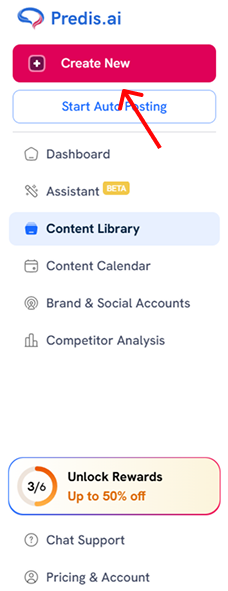
- Select “Voiceover video” under the “Business” section to start making your video.
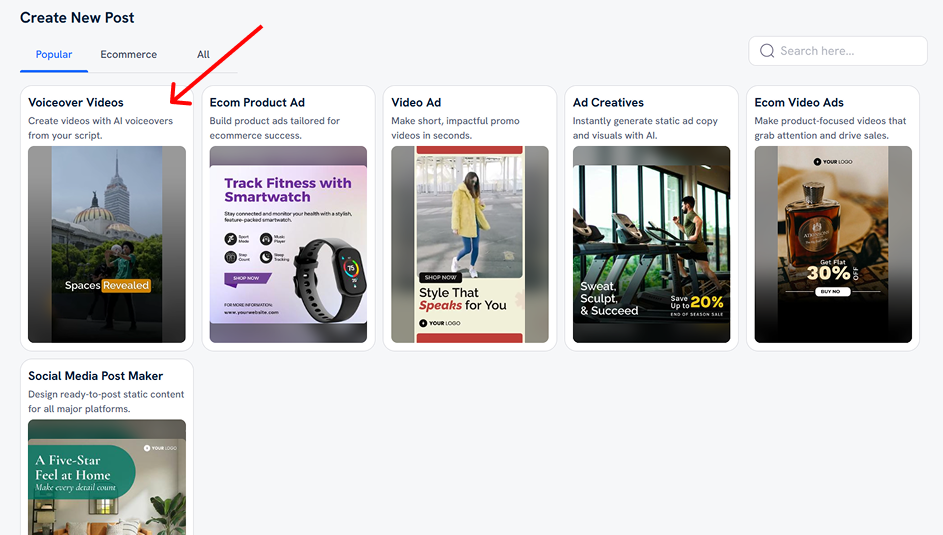
- On the next page, you have to enter a text prompt describing in detail the kind of post that you want to create, which can be a video script or a blog post. Adjust the aspect ratio and the kind of images that you want, such as AI-generated ones or stock videos.
- Once you are satisfied with the changes that you made, click “Generate”, and the AI will render your video in a few minutes.
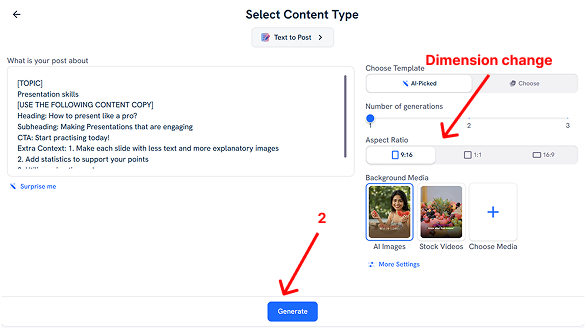
Adding them to the Content Calendar, aka Scheduling Them
Now that the content has been made, it is time to undergo the Video Content Calendar creation process. The beauty of Predis AI’s content calendar is that you can schedule the content simultaneously when you add it to the calendar, which gives a totally automated experience.
To do that, follow these steps:
- Select the “Content Calendar” option in the left side menu bar.
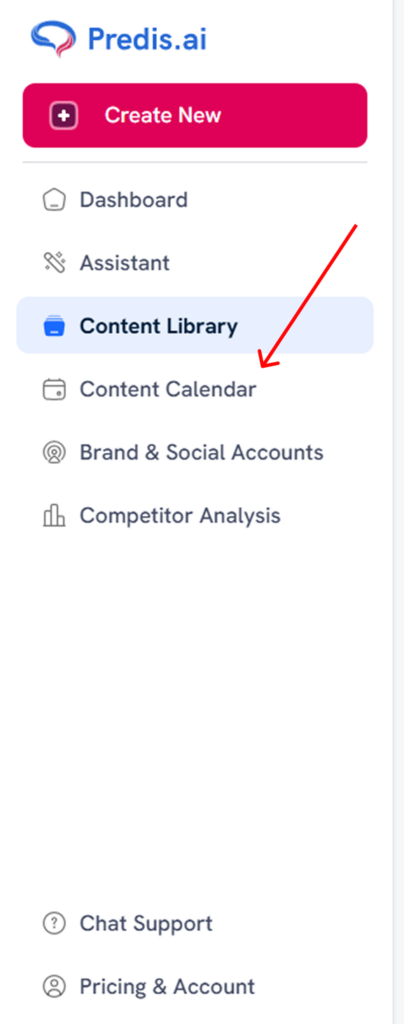
- Click on the day of the month that you want this content to go out on.
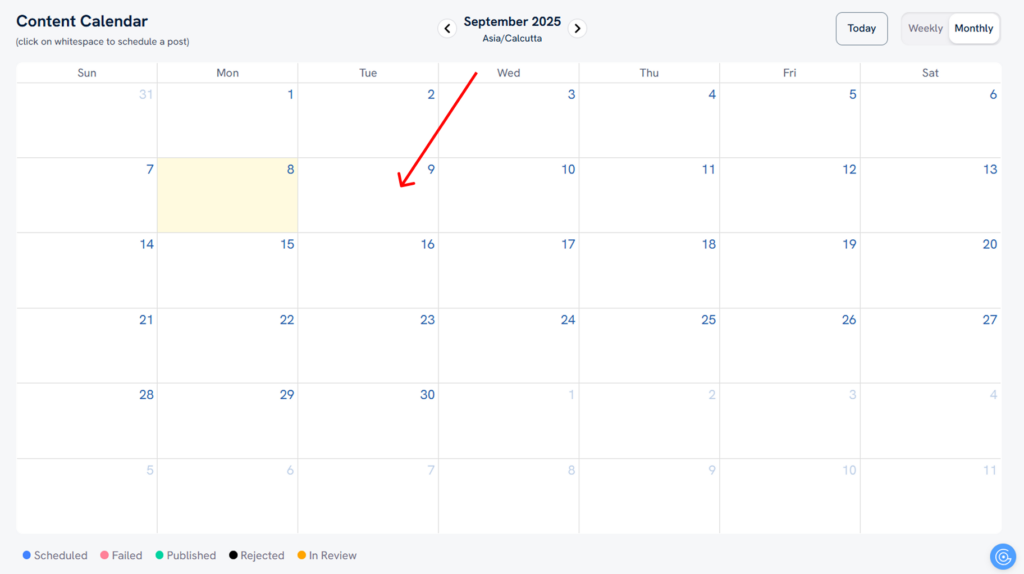
- A pop-up box will appear that shows the content that you have already created, along with other ones that you might have made. Pick the right video.
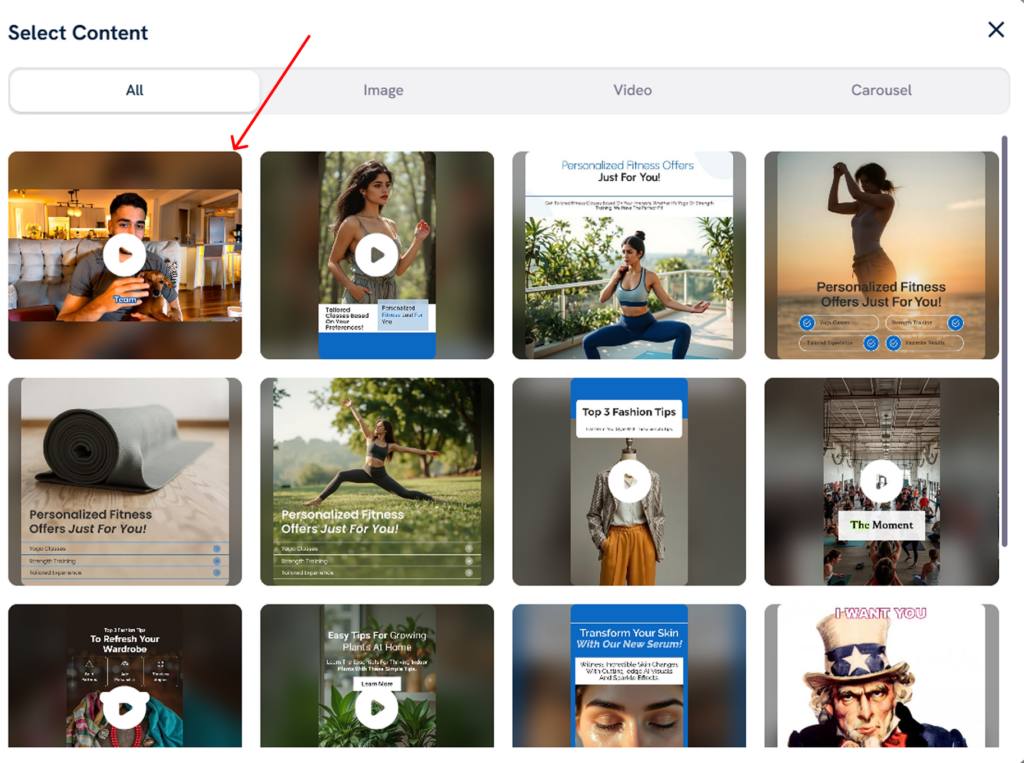
- Pick the platform that you want to post it on, which can be anything like Instagram, Facebook, or TikTok. If your accounts are not yet linked to the Predis profile, then this is where you should be doing it.
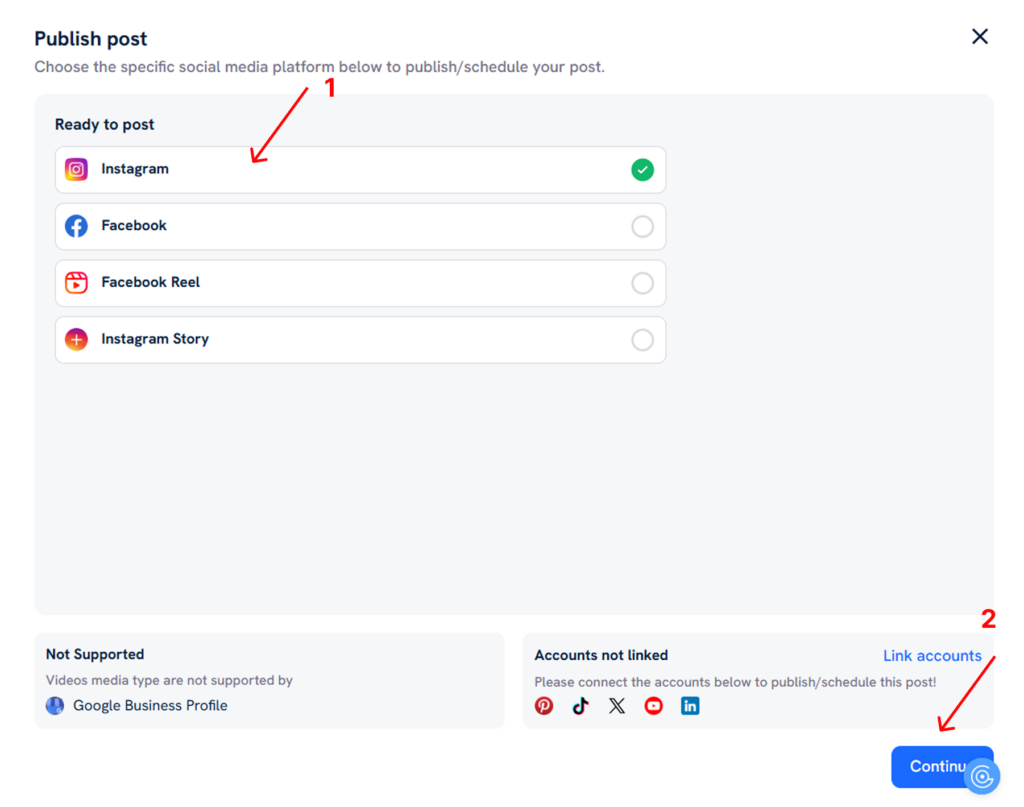
- Once you have picked the right platform, click “Continue”.
- Choose the date and time you want the post to go out on. You can even let AI do its thing and find the best time to post. If you have to get approval before it publishes, then you can even add that team member at this step.
- After you have set up everything, click “Schedule Post”, and the post will be scheduled along with being visible on the content calendar.
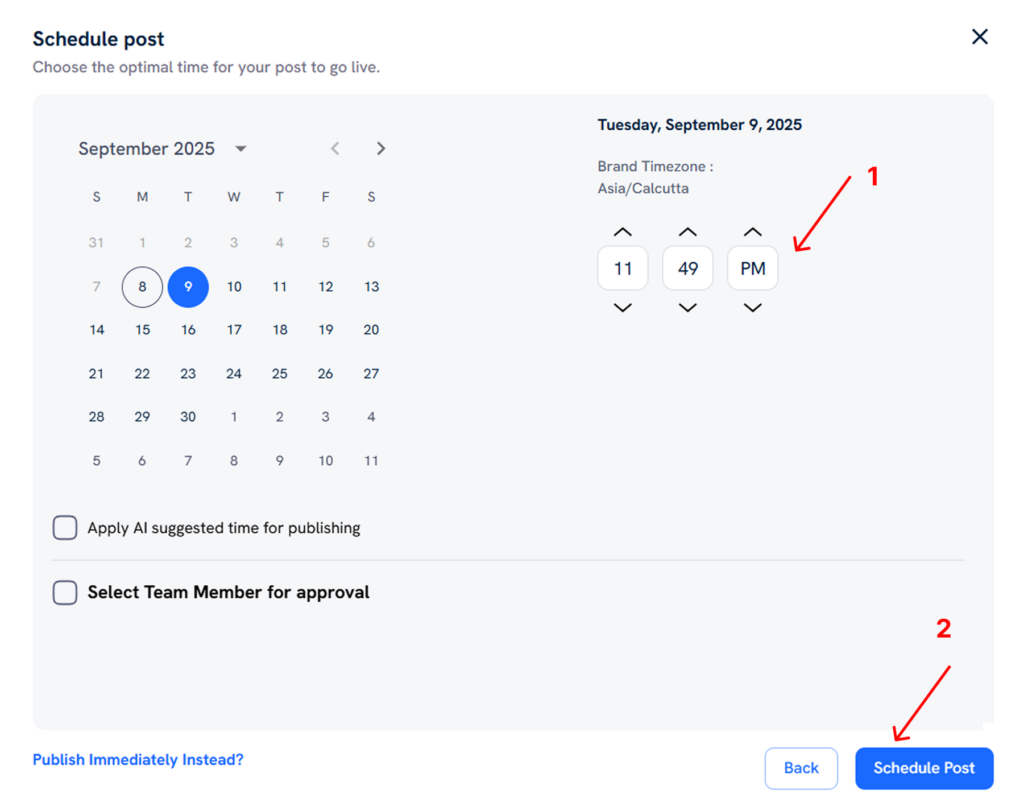
All that is left for you to do is sit back and relax because Predis AI will do the rest for you.
How To Plan Your Video Content Calendar Like a Pro?
As a newbie, planning out a content calendar can feel overwhelming. But if approached methodically, you can tackle this task easily, too. This is why we have a 7-step framework in the video content calendar creation that gives you the most bang for your buck!
1. What is the objective of these videos?
Without a final goal, you will not be able to figure out a way to measure your progress. So, the first step here must be to figure out what the point of these videos is.
- Is it brand awareness?
- Do you want to bring more new people to your website?
- Do you want better engagement rates?
- Is it a lead generation campaign?
Based on these questions, create a plan for the kind of videos that you want to make throughout the month and what metrics to track.
2. Find who you are targeting
A video content calendar can be something for your business, but the actual person who is going to experience it is the audience. Therefore, a considerable amount of thought has to go into identifying these people and what they are looking for from your brand.
As a part of this process:
- Create an audience persona based on what you know of your audience. This can contain everything from interests, demographics, pain points, and preferred social media channels.
- Match this profile with the type of people who are watching your videos and see if the two match.
- Make interactive videos that gather feedback from your viewers so you can find out what they actually like.
- Conduct surveys and be updated on their requirements, and update your audience persona whenever something new emerges.
- Make a note of their preferred social media channels and post on them consistently to ensure you are on top of their mind.
3. Finalize the type of content
With your audience requirements and your goals laid out properly, the next step is pretty easy. This is figuring out the kind of content that you are going to be posting, along with the channels that you are supposed to focus on.
In this process, you can take the following steps:
- Figure out the type of video content you want to post. This can be anything from tutorials to product demos and testimonials.
- What keywords are you going to be focusing on? Because SEO is still a big part, even if you are doing video marketing. Find out these keywords, so you can use them actively in your titles, meta descriptions, and so on.
- Which channels are you going to be posting on? At this point, usually, pick a platform that your target audience frequents.

4. Determine the frequency of your posting schedule
In the beginning, it can be exciting, and you might think you are going to be posting 5x a week. But this approach is not sustainable till the end. You will eventually get burnt out and not post for a couple of weeks, which could tank your engagement.
To avoid such a scenario from happening, you need a schedule that will keep your audience engaged and still help you be consistent. Some of the things that you need to figure out at this part of the process are:
- What video themes are you going to be focusing on at what time?
- How often are you going to be publishing on each social media platform?
- What posting times are best for your audience?
5. Set up your Video Content Calendar
Now that you have everything you need to set up your video calendar, it is time to assemble it all together.
We already saw how Predis AI lets you utilize their pre-made content calendar. Utilize the same methodology and start creating content and scheduling it from the same platform.
This allows you to do everything from one place without having to jump between multiple platforms to get one objective done.
6. Track the performance of video posts
Monitoring the performance of the videos is vital to improving them in the long run. So, always have time in your schedule to analyse your past posts and figure out what is working and what is not.
In most cases, the platform you are posting on will already have an analytics dashboard for you to dive into. Additionally, Predis AI also has its own analytics dashboard to help you understand the numbers behind the video. It goes a step further and converts this data into actionable insights that the AI will suggest to you when you are making your next video!
Apart from that, if you are looking to track website conversions and traffic from this video, then you can implement UTM and custom URLs.
7. Rinse and repeat by evolving your strategy
Now, with some deeper insights into the audience preference, it is vital to consider these and change the strategy accordingly.
As a part of this, you can:
- Cross-promote your videos to other platforms to see how your audience reacts
- Find trends that you can capitalise on and see if people love your normal posts or the trendy ones
- Are your audience reacting to the video the way you wanted them to, or do you need to adjust your strategy to meet your KPIs?
When you keep learning from your audience behavior and make the necessary changes, you are bound to reach your KPIs without an issue.
Best Practices to Keep in Mind When Creating a Video Content Calendar
Creating a video content calendar with Predis AI can be an easy-peasy task. To make it the most efficient one, you can follow some of these best practices:
- Make some time for analyzing video analytics and making changes to your strategy.
- Input your brand elements into every video that goes out
- Do not sacrifice quality for quantity. Because even one well-created video can be a huge game-changer
- Repurpose well-performing content occasionally to make it evergreen
- Plan your video content days ahead of time and keep your schedule flexible

Start Creating Your Own Video Content Calendar!
Making a video content calendar can take a huge burden off your shoulders, ensure you are consistent, and give your audience the content they deserve. This content calendar-making process would have been hectic if you had to do it the manual way with Google Sheets or Excel.
But thanks to Predis AI, you have a built-in template that is ready for you to use. And as an added plus, it also allows you to schedule your content directly to your channels, helping you with a more hands-off approach.
So, what are you waiting for? Sign up to get your free account today with Predis AI and start scheduling your social media content now!
FAQ:
A video content calendar is a way to maintain all your video content, publishing schedule, and the platform that is going to be published on, in one place. This way, you can get an overview of your complete video strategy from one screen.
With AI, you get to hit the ground running with a pre-built video content calendar. It also offers automated scheduling, which is a huge advantage when compared to manually created content calendars.





